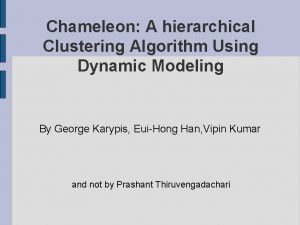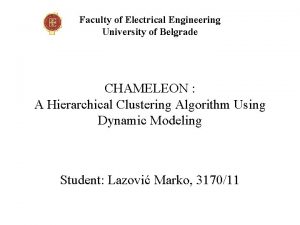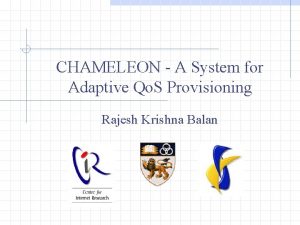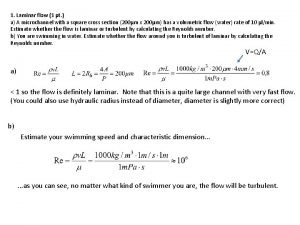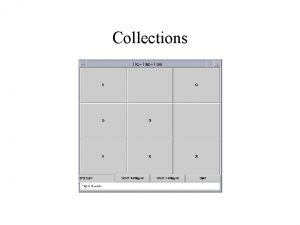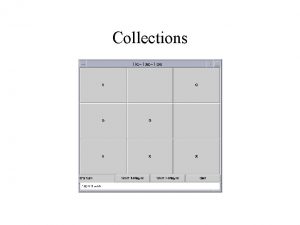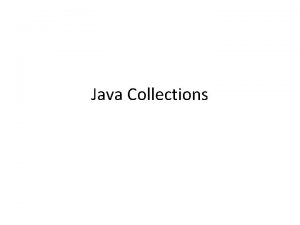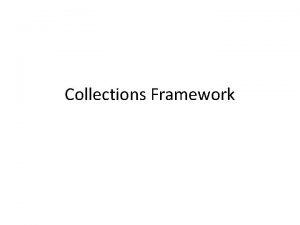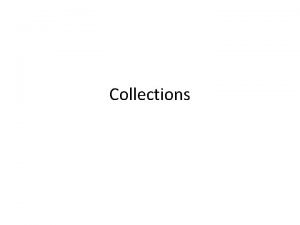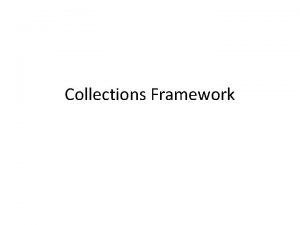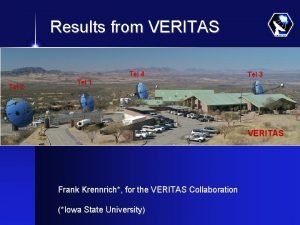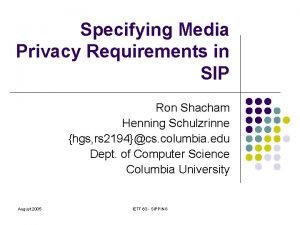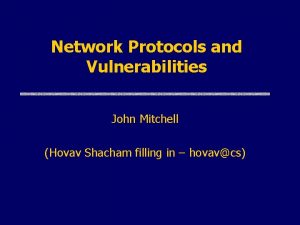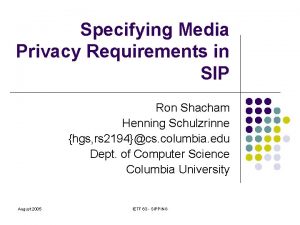Chameleon Automatic Selection of Collections Ohad Shacham Tel
























- Slides: 24

Chameleon Automatic Selection of Collections Ohad Shacham Tel Aviv University Martin Vechev Eran Yahav IBM T. J. Watson Research Center Presented by: Yingyi Bu

Collections l l Abstract data types Many implementations Different space/time tradeoffs Incompatible selection might lead to l l runtime degradation Space bloat – wasted space Set Hash. Set Linked. Set Array. Set Lazy. Set Map Hash. Map Linked. Map Array. Map Lazy. Map Linked. List Array. List Lazy. List

Collection Bloat l Collection bloat is a non justified space overhead for storing data in collections List s = new Array. List(); s. add(1); 1 Bloat for s is 9

Collection Bloat l Collection-bloat is a serious problem in practice l l Hard to detect and fix l l l Observed to occupy 90% of the heap in real-world applications Accumulation: death by a thousand cuts Correction: Need to correlate bloat to program code How to pick the right implementation? l l Minimize bloat But without degrading running time

Our Vision l Programmer declares the ADT to be used l Set s = new Set(); l Programmer defines what metric to optimize l e. g. space-time l Runtime automatically selects implementation based on metric l Online: detect application usage of Set l Online: select appropriate implementation of Set Hash. Set Array. Set Linked. Set …

This Work l Programmer defines the implementation to be used l l Programmer defines what metric to optimize l l l Set s = new Hash. Set(); space-time product Space = Bloat Runtime suggests implementation based on metric l l l Online: automatically detect application usage of Hash. Set() Online: automatically suggest alternative to Hash. Set() Offline: programmer modifies program accordingly l e. g. Set s = new Array. Set();

How Can We Calculate Bloat ? l Data structure Bloat l l Occupied Data – Used Data Example: List s = new Array. List(); s. add(1); 1 Bloat for s is 9

How to Detect Collection Bloat? l Each collection maintains a field for used data l Language runtime can find out actually occupied data l l Bloat = Occupied Data – Used Data Solution: Garbage Collector Computes Bloat Online l l Reads used data fields from collections Low-overhead: can work online in production

Semantic Maps l How Collections Communicate Information to GC l l Includes size and pointers to actual data fields Allows for trivial support of Custom Collections Array. List … int size … Object[] Array … … Array. List Semantic map Hash. Map Semantic map Used Data Occupied Data GC Hash. Map … element. Count … element. Data …

Example: Collections Bloat in TVLA

Example: Collections Bloat in TVLA

Example: Collections Bloat in TVLA Lower bound for bloat

Fixing Bloat l Must correlate all bloat stats to program point l Need Trace Information l Remember: do not want to degrade time

Correlating Code and Bloat l l Aggregate bloat potential per allocation context Done by the garbage collector public final class Concrete. KAry. Predicate extends Concrete. Predicate { … public void modify() { … values = Hash. Map. Factory. make(this. values); } … } public class Generic. Blur extends Blur { … public void blur(TVS structure) { … Map inv. Canonic. Name =Hash. Map. Factory. make(structure. nodes(). size()); … } } public class Hash. Map. Factory { public static Map make(int size) { return new Hash. Map(size); } } Ctx 1 40% Ctx 4 7% Ctx 2 11% Ctx 5 5% Ctx 6 3% Ctx 8 3% Ctx 7 7% Ctx 3 5%

Trace Information l Track Collection Usage in Library: l l l Distribution of operations Distribution of size Aggregated per allocation context ctx 1 Size = 7 Get = 3 Add = 9 …. ctx 2 Size = 1 Contains = 100 Insert = 1 …. ctx 3 Size = 103 Contains = 10041 Insert = 140 Remove = 20 … ctxi …. ….

But how to choose the new Collection ? l Rule Engine: user defined rules l l l Input: Heap and Trace Statistics per-context Output: Suggested Collection for that context Rules based on trace and heap information l l Hash. Map: #contains < X Collmax. Size < Y → Array. Map Hash. Map: #contains < X Collmax. Size < Y+10 %live. Heap > Z → Array. Map Rule Engine Hashmap: max. Size < X → Array. Map Linked. List: No. List. Op → Array. List Hashmap: (#contains < X Collmax. Size < Y+10 %live. Heap > Z ) → Array. Map …

Overall Picture Potential report Recommendations Semantic Profiler Rule Engine Program ctx 1 Size = 7 Get = 3 Add = 9 …. ctx 2 Size = 1 Contains = 100 Insert = 1 …. Semantic maps Hashmap: max. Size < X → Array. Map Linked. List: No. List. Op → Array. List Hashmap: (#contains < X Collmax. Size < Y+10 %live. Heap > Z ) → Array. Map … … … Rules

Correct Collection Bloat – Typical Usage l Step 1: Profile for Bloat without Context l l Step 2: Combine heap information with trace information per context l l Can switch automatically to step 2 from step 1 Higher-overhead than step 1 Automatic: prior to Chameleon - a manual step (very hard) Step 3: Suggest fixes to user based on rules l l Low-overhead, can run in production If problem detected, go to step 2 Automatic Step 4: Programmer applies suggested fixes l Manual

Chameleon on TVLA 1: Hash. Map: tvla. . . Hash. Map. Factory: 31 ; tvla. core. base. Base. TVS: 50 replace with Array. Map … Size Operations Potential 4: Array. List: Base. Hash. TVSSet: 112; tvla. . . base. Base. Hash. TVSSet: 60 set initial capacity Max Avg Stddev 15 11. 33 1. 36 26 6. 31 5. 05 7 4. 8 1. 17

Implementation l Built on top of IBM’s JVM l Modifications to Parallel Mark and Sweep GC l Modular changes, readily applicable to other GCs l Modifications to collection libraries l Runtime overhead l l Detection Phase: Negligible Correction Phase: ~2 x (due to cost of getting context) l Can Use PCC by Bond & Mc. Kinley

Experimental Results – Memory

Experimental Results – Time

Related Work l Large volume of work on SETL l l Automatic data structure selection in SETL [Schonberg et. al. , POPL'79] SETL representation sublanguage [Dewar et. al, TOPLAS'79] … Bloat l The Causes of Bloat, The Limits of Health [ Mitchell and Sevitsky, OOPSLA’ 07]

Summary l Collection selection is a real problem l l l Chameleon integrates trace and heap information for choosing a collection implementation l l based on predefined rules Using Chameleon, reduced the footprint of several applications l l Runtime penalty Bloat Never degrading running time, often improving it First step towards automatic collection selection as part of the runtime system
 Microsoft cloud os
Microsoft cloud os Hovav shacham
Hovav shacham Something that moves
Something that moves Chameleon clustering algorithm
Chameleon clustering algorithm Chameleón leopardí
Chameleón leopardí Comma comma comma chameleon meme
Comma comma comma chameleon meme Wisi chameleon
Wisi chameleon Chameleon attacking in dream
Chameleon attacking in dream Ds3 how to get chameleon
Ds3 how to get chameleon The chameleon effect
The chameleon effect Router en chameleon
Router en chameleon Chameleon ea performance
Chameleon ea performance Balancing selection vs stabilizing selection
Balancing selection vs stabilizing selection Disruptive selection
Disruptive selection Multiway selection
Multiway selection Similarities
Similarities What is exponential growth in ecology
What is exponential growth in ecology Procedure of pure line selection
Procedure of pure line selection Natural selection vs artificial selection
Natural selection vs artificial selection K selected
K selected Natural selection vs artificial selection
Natural selection vs artificial selection Difference between continuous and discontinuous variation
Difference between continuous and discontinuous variation Two way selection and multiway selection in c
Two way selection and multiway selection in c Tel laminar 37m
Tel laminar 37m Tel. fax
Tel. fax



